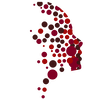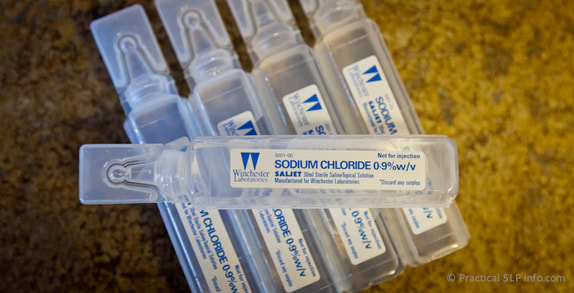Smelling
Following a tracheostomy, many patients report not being able to smell as they did before. The sense of smell, or olfaction, remains intact as there is no impact from the surgery to the nerves of olfaction that allow for smelling scents, aromas and odors. What has changed, however, is the pathway of airflow during respiration. Prior to the tracheostomy, air would flow into the body through the nose and mouth. This movement of air through the nose allowed for scents and aromas to be detected as the smells came in contact with the tiny nerve endings in the nose that are responsible for the sense of smell.
Following a tracheostomy, however, there is minimal, if any, active flow of air through the nose during breathing. This can be perceived as a loss of smell. Olfaction can be restored, at least temporarily, by covering the end of the tracheostomy tube and allowing air to be inhaled through the nose. For short instances (example: smelling a rose), this can help a tracheostomy patient better appreciate scents and aromas. This technique, however, may not be comfortable (or even possible) if the upper passageways of respiration are severely blocked.
Filtration
Before a tracheostomy, the nose helps to filter the air that is inhaled. After the surgery, all the air you breathe goes in and out of the tracheostomy tube, bypassing the natural filtration of the nose. It is very important to stay away from smoke, dust and other pollutants, as these will be inhaled directly into your lungs.
Tasting
Because our sense of taste is strongly related to our sense of smell, you will notice that foods may no longer taste the way they did before the surgery. The tongue is able to detect five basic tastes: sweet, sour, salt, bitter and savory - 70% of our sense of taste, however, comes from our sense of smell. Our sense of smell adds to the taste of our food and allows us to recognize the difference between steak and pizza, for example. Once you start eating following a tracheostomy, you will notice that your favorite foods may taste quite different from what you remember.
Coughing
Coughing as a neck breather means anything you should expel from your lungs will be expelled or coughed out through your stoma. Although you are accustomed to covering your mouth when you cough, you will learn instead to cover your tube opening. Initially following surgery and for several weeks thereafter, you will likely cough a great deal of mucous and secretions from your lungs. The lungs are increasing the output of secretions and mucous in response to the changes in your anatomy and physiology. Regular application of an HME assists with restoring normal lung function by delivering the heated/warmed and humidified air the lungs are accustomed to. Over time with regular HME application, the secretion production will slow down.
Many patients are concerned to see, despite regular HME application, they continue to cough mucous from their tube. It should be stressed that the lungs should normally produce mucous in healthy people as a protective layer to help keep lung tissue moist as well as to serve to trap inhaled particles that may be harmful to lung tissue. In any person, these secretions are coughed frequently during the course of a normal day and typically swallowed. Following a tracheostomy, however, these secretions must be expelled from the tube and wiped away. It is important to remember this is quite normal, although Dr. Ducic or Katrina may be able to offer suggestions for improved secretion management if it seems atypical.
Humidification
The air we inhale, is typically filtered, heated and humidified first as it passes through the moist pathway of the nose, mouth and throat. Following a tracheostomy, however, this is no longer the case. As a result, the air that is inhaled directly by the lungs is less humid than is normal. This can result in changes to lung function and secretion management. For this reason, we will always recommend methods to improve the humidification of the lung tissues and passageways. The following details various options used in this practice. These can be used alone or in combination with one another. Your doctor/SLP staff will inform you of the most appropriate way to compensate for diminished humidification.
- HMEs: In addition to filtering the air, breathing in through the nose and mouth also helps to heat and humidify air that is inhaled. After a tracheostomy, inhaled air through the tube enters the lungs without first being humidified or heated since it is no longer being inhaled through the nose/mouth. A heat and moisture exchange cap, or HME, can be utilized after your surgery to assist with these changes.
- Electric Humidifiers: It is also recommended by this practice that patients begin using humidifiers, especially at night by the bedside. Regular inhalation of non-humidified air can have a drying effect on the tissues of the respiratory tract and lungs. Breathing non-humidified air will also cause thickening and drying of lung secretions/mucous and contribute to the formation of mucous plugs. A mucous plug is a collection of thickened mucous that is large enough to potentially plug the tracheostomy tube. Proper humidification can assist in minimizing the potential for developing mucous plugs.
- Saline Bullets: A saline bullet is a term used to describe a small vial of sterile saline. These can range in size from 5-30ml, although the SLP staff will typically prescribe the 30 ml size for use.
Tracheostomy patients using an HME typically will not need saline bullets once their HME use is initiated and consistent.
- Indications: Saline bullets are used to provide quick, temporary moisture to the pulmonary air passages and lungs and are most commonly used to correct issues related to inadequate humidification for tracheostomy patients not regularly using HMEs.
Saline bullet utilization can be helpful in loosening dried mucous and mucous plugs as well as restoring moisture to dry airways. These should only be used on the advice of your doctor or SLP staff.
- Directions for Use (with 30ml Vial):
Position the tip of the vial into the opening of the tracheostomy tube (speaking valve/HME removed). While inhaling, squeeze firmly on the vial, releasing ~1/3 or 10ml at one time. This will likely cause coughing. After secretions have been cleared, repeat this until the vial is empty, usually 3-4 times in total. It may be helpful to use suction during this procedure to better help clear mucous from the tube.
It is important to use saline bullets in the morning. This will help to moisturize the air passages and clear any dry secretions that may have formed during sleep, so you can be more comfortable through your day. Your doctor or SLP staff will advise you on how often and when to use saline bullets if you require more that once daily. These can be used safely more than once daily, but you may be prescribed a specific schedule.


